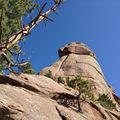Tag:natural=bare rock - Other languages
An area of bare rock is sparsely vegetated or not vegetated at all, so that the solid bedrock becomes visible. Areas to tag could be:
- high altitude mountain areas where the rock lays bare, like summits, arêtes and rock faces, but not scree, shingle or moraines.
- rocky coasts
- rocky areas in uplands, desert and polar regions
- outcrops like open pit mines or road cuts
- monolithic mountains like Uluru (Ayers Rock).
How to map
To map an area of bare rock you can just draw a line closing on itself, marking the area as bare rock. To map larger or more complex areas you can use relation:multipolygon with the same tag.
It can be mapped as a node (if there is no way to map it as a geometry), especially when someone wants to map name or some other additional properties. But mapping as an area is strictly preferable.
Examples
Precambrium Granite exposed at "The Castle" near Wellington Lake, Colorado, USA.
Triassic Limestone (Wettersteinkalk) in the "Wilder Kaiser", Northern Calcareous Alps (Austria, Scheffau)
Stony coast at Susak Island, Croatia
Rendering
See also
- natural=cliff - steep natural drop in terrain topography
- natural=blockfield - pile of rocks, often formed as a result of volcanic or glacial activity.
- natural=scree - loose angular rock fragments formed by rockfall and weathering from adjacent rock faces
- natural=shingle - rounded rock fragments on a beach or riverbed, deposited and shaped by movement of water
- natural=stone - large boulders (glacial erratics or rock fall) not attached to the bedrock, mainly single node element
- natural=rock - isolated, notable rock features connected to the bedrock, mainly single node element
- natural=glacier - glacier areas
Possible tagging mistakes






